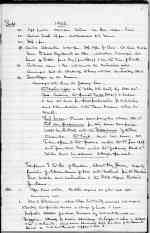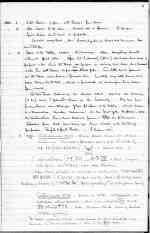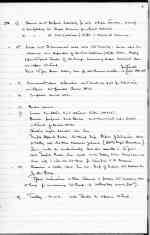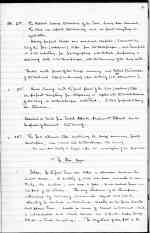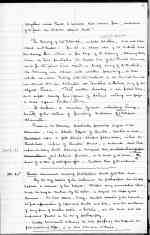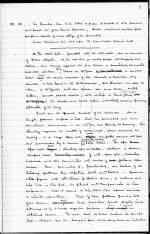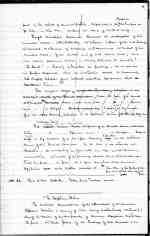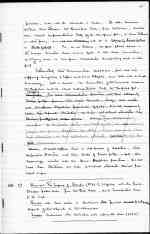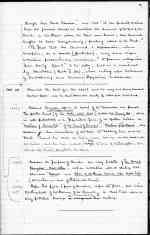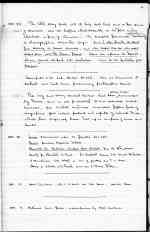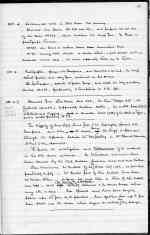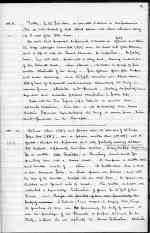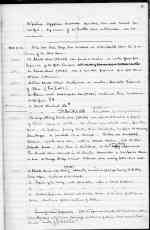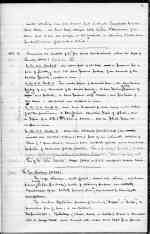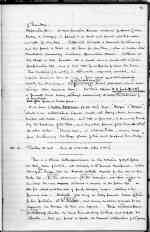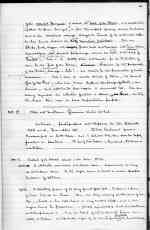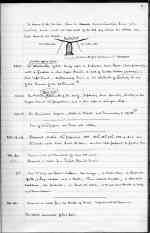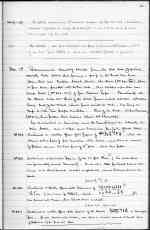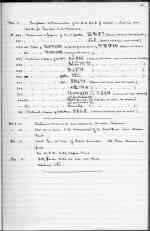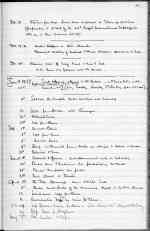Excavation journals and diaries made by Howard Carter and Arthur Mace
Howard Carter's excavation diaries (transcripts and scans)
5th Season, September 22nd 1926 to May 3rd 1927
This is Howard Carter's journal for the 5th excavation season of the tomb of Tutankhamun which took place between Autumn 1926 and Spring 1927. The events covered by this journal are the return of Tutankhamun’s mummy to his sarcophagus within the tomb and the initial assessment of the Treasury (October 23rd 1926), the removal of the Anubis-jackal shrine from the Treasury (October 27th 1926), and the opening of a black shrine-like chest which contained five statuettes of Tutankhamun (November 8th 1926).
The journal is a bound buff-coloured volume with a printed "Egyptian Government" label on the front cover board, it measures 33.5 by 21.5 by 1.5 cm. and contains journal entries on 65 ruled pages. TAA Archive i.2.4, pages 1 to 25. All entries are in Howard Carter's hand.
This transcript follows the format of the original document, and any insertions, deletions or duplications are indicated accordingly. Scans of the original journal pages are provided and are positioned to the right of the transcript, these are magnified by positioning the pointer on the image.
Left London 10.45am. Victoria. Via Dover - Calais - Paris.
Arrived Trieste 9. pm. And embarked S.S. Vienna.
Dep. 1. pm.
Arrived Alexandria 2.30pm. Dep. 6pm for Cairo. Arr. Cairo. 9.45pm.
Met Dr. Saleh Bey Hamdi at Alex., with whom I arranged that
I would go to Alex. For a day (from Cairo) to see the Min. of P.W.D.
A. Lucas came to dine with me at the Continental Hotel.
Arranged that he shall go to Luxor with me on Tuesday Oct. 5.
Saw Edgar at the Museum.
Arranged with him the following items:
The electric light in the valley to be ready by Oct. 20th.
Case containing the painted casket No. 21) to be sent
to me at Luxor for final preparation for exhibiting
and to be returned to the Cairo Museum within the
month.
That Lucas should accompany me to Luxor Oct. 5th.
That our programme for this season's campaign
would be to deal with the 'déblaiement' of the Store
Chamber. The tomb, as in last season, not
to be open to the public until the 1st Jan 1927.
and from that date until the following March 15th.
Visitors should be allowed 3 days per week.
Telephoned to the Dir. Of Customs, Ahmed Bey Gharto, regarding
customs of eleven cases of stores and materials per S.S. 'Ranpura'.S.S.
Sent invoices and instructions to the P&O. agent Port Said
for same.
Edgar dined with me. Bulletin required end of first week after
commencing work.
Went to the Museum, where Edgar had kindly arranged with regard
to sending the painted casket in charge of Lucas to Luxor.
Inspected skeleton of a horse discovered by Firth and Quibell at
Saqqara. Allowing for certain shrinkage its height to withers is 160 cms
= 60" = 15 hands, which seems abnormally high for a horse of the Ramesside
period as Firth and Quibell appear to date it.
Left Cairo. 7.pm, with Lucas for Luxor.
Arr. Luxor 8.30am. Crossed over to Gurna. 9.30am.
Find house and men in good order.
Weather very cool, but house, by being closed all summer, hot
and stuffy.
Went to the Valley 10.am. This morning, where everything seemed
to be in good order. Open the Laboratory (No. 15) which would have been in
perfect order had the Reises not failed in noticing that rats had burrowed
under the wood-screen before
at the base would have prevented this. Luckily very little harm had
been done by the rats, which is fortunate, as it might have been
far worse.
The two cases containing the casket No. 21 arrived this morning
11.30) and I placed them in the Laboratory. They were sent
from Luxor in charge of two ghaffirs to the Valley, which seems
a somewhat careless manner on the part of the Inspector, after
the instructions he had received from Edgar at the Museum.
I rather fear that we may yet have trouble with the Chief
Inspector. Tewfik Effendi Boulos. - I hope not!
Note Antechamber No. 37. Black shrine-shaped box (on sled)
containing standard (gesso-gilt wood) of the 10th Nome of
Up. Eg. (Aphroditopolis) upon black pedestal, in yellow paint crudely written: 
 = "The good god, Kheperu-Neb-Re, Beloved
= "The good god, Kheperu-Neb-Re, Beloved
Chiefeness of Heaven ( goddess of writing)" (or goddess of Heaven, Seshat).
goddess of writing)" (or goddess of Heaven, Seshat).
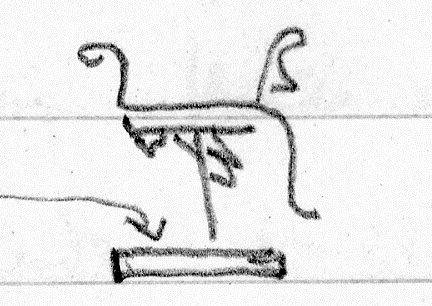 = nome sign of Aphroditopolis (
= nome sign of Aphroditopolis (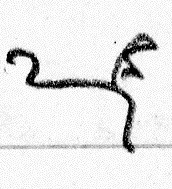 ,
, 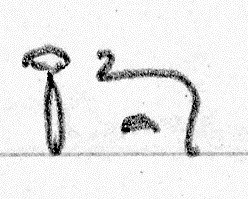 and
and 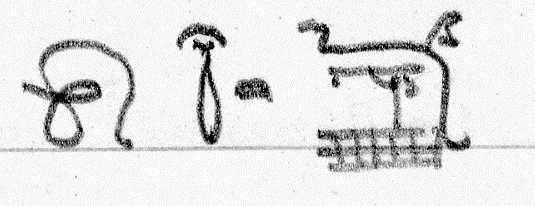 = Green, to be green,
= Green, to be green,
to be fresh, and to grow) upon nome standard.
Antechamber No. 38, Same as No. 37, with exception the
inscription upon pedestal, this is very illegible, but (?) reads:
 , "Osiris, Kheperu-Neb-Re, Beloved of Seshat"
, "Osiris, Kheperu-Neb-Re, Beloved of Seshat"
(the goddess of writing).
The boxes, of shrine-shape, which housed the above standards, are
similar in build and shape to those in the Store-Room.
Cleaned and prepared Laboratory for work to begin tomorrow, namely:
(1) Completing the Royal Mummy for final reburial.
(2) " the First (outermost) coffin to receive the mummy.
Lucas and I commenced real work this morning: Lucas upon the
cleaning and reparation of the First (outermost) coffin shell; Myself
upon the final touches of the King's mummy before reburial when
we open the tomb.
Paid the four Reises salary due for the Summer months, i.e., from June 30th up to Oct. 31st.
Commenced upon reparation and making good for exhibition
in Cairo the painted Casket No. 21.
Completed Casket No. 21.
Burton arrived.
Lucas completed First outermost Coffin (No. 243).
Burton prepared dark room and commenced upon photos
in detail of Casket No. 21.
Electric light started this am.
Tewfik Effendi Boulos, the Chief Insp. Depart. Of Antiquities, came
to Valley with the New Marmour of Luxor (Abd El Megid Shenasheen.).
I am under the understanding that this was the is the first
visit Tewfik Boulos has made to the Valley since May last, and
then only to take over the cases for transport to the Museum.
Received in Valley visit from the Insp. Of Interior and Hakam Ins.
of the Police.
Gave instructions to Reis Ahmed to procure the necessary men
& boys for uncovering the tomb on Wednesday morning (20th).
Tuesday. No work. Wrote Tewfik re opening the tomb.
The rubbish covering the entrance of the tomb having been removed,
the tomb was opened this morning and we found everything in
good order.
Having prepared tackle and overhead scaffold, I removed the
lid of the first (outermost) coffin from the sarcophagus, and transported
it to the laboratory, for photographing with its shell, preparatory to
returning both to the sarcophagus, with the mummy of the King inside.
Burton made photos of the King's mummy and detail photographs
of the bead work left (under-wax) upon the King (i.e., Nos SSS and TTT).
Burton having made the final photos of the First (outermost) Coffin,
we prepared everything for replacing it together with the mortal remains
of the King in the sarcophagus in the tomb, a task proposed to carry
out tomorrow.
Received a visit from Tewfik Effendi, Mahmoud Effendi and the
Inspector of Karnak this morning.
The first outermost coffin containing the King's mummy, finally
rewrapped, was lowered into the sarcophagus this morning.
We are now ready to begin upon the investigation of the Store Room.
The Store Room.
x When, for the first time one enters a chamber such as this
inmost recess, the sanctity of which has been inviolate for over
thirty-two centuries, an awe is felt, if not actual fear, on
the part of the intruder. The very stillness of its atmosphere,
intensified by the many inanimate objects that fill it,
standing for centuries and centuries exactly as the pious hands
had placed them, creates a sence
is indescribable and which causes one to ponder before daring
to enter or touch anything. The very tread of ones foot or the
slightest noise tends to increase that nervous fear, unconscious
of the fact one becomes almost mute!
The doorway of this chamber, unlike the others those of the [other] chambers, had not been
closed and sealed: from it a clear view of the contents could
be seen. But within a few days of its discovery, February 1923,
when we first penetrated the sealed door of the Burial Chamber,
and for the first time made a brief survey of its contents,
the doorway was closed with wooden planking, so that
while we were dealing with the material in the Burial Chamber
we should not be distracted nor tempted to disturb any of the
objects therein. That wooden planking is now pulled down,
and after nearly four years of patient waiting our gaze
is once again directed within.
It contains a number of most interesting things,
mostly of the nature of funerary emblems of intense religious
character.
Placed in the doorway, practically preventing ingress to the
chamber, lay a black figure of Anubis, swathed in linen,
couchant upon a gilt shrine-shaped palankeen
thresh hold
(see p. 13) upon a clay brick bearing a magical text, in white hieroglyphic
characters and behind Anubis, in the centre of the room, the a strange
x head of a cow (1) of wood gesso-gilt - Emblems those of the underworld (2).
Notes
(1) Head of the Meht-writ cow, which in all probability is a
figurative form of the goddess Hathor as 'Mistress of Amentit,
of 'the Land of Sunset', Mistress of Ta zesert (the Sacred Land), called 'The Eye of Re', who receives in
her mountain of the west the setting sun and the dead.
Erman Vol.
p. 69.  Mht-wrt heavenly cow
Mht-wrt heavenly cow
p. 16.  , ỉrt rʿ, name of Hathor (the Eye of Re)
, ỉrt rʿ, name of Hathor (the Eye of Re)
cf. Erman, Eg. Religion, pp. 12, 18, and 31.
Pap. Am. Pl. 8 Chap. 17. 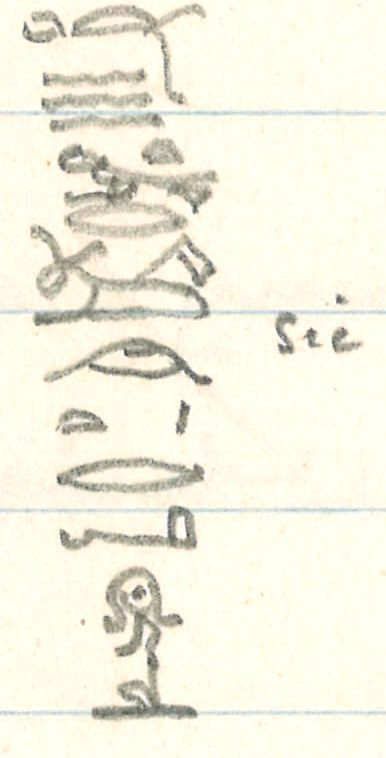 Le Page Renouf p. 12. the great cow "Meh-wrt", the Eye of Ra
Le Page Renouf p. 12. the great cow "Meh-wrt", the Eye of Ra
with the flail and with the symbol menat round the neck.
(2) "Emblems of the dark world under the Earth, to which the sun sinks in the West,
and where also the dead belong."
Burton commenced making photographic records of the Store-room.
By the very nature of his instrument the photographer can simply
capture a moment of his subject; therefore any cumulative effort,
such as may be rendered by the artist, is beyond the scope of the
camera. For that reason, I say, careful selection of the subject,
the full appreciation of light and shade and pose, and the avoidance
of any form of arrested action or distortion, are the real and all
important factors in the art of photography.
Lucas commenced repairing the bier (No. 2453a) that supported the
first (outermost) coffin, as it has to be sent to Cairo.
As Anubis has to be taken to pieces to enable it to be removed
and passed out of the Burial Chamber, Burton continued making photo-
graphic records of each stage of the proceeding.
Lucas continued his work upon the lion-shaped bier, in Lab.
Paid the men yesterday. Today being Tuesday no work.
Removed the figure of Anubis (No. 261) together with his pylon-
shaped palankeen from the Store Room, and transported them
to the Lab.
records of the objects in the chamber.
Lucas continued his restoration work upon the bier (253a).
Removed the head of a cow (264) and the ivory and ebony veneered
casket (267), into the Antechamber ready for transport to the Lab.
(263) The little clay brick with its tiny reed torch and a few grains
of charcoal were not dropped haphazardly on the floor within
threshold in front of Anubis; the magical formula scratched upon it
in hieroglyphic characters says: "It is I who hinder the sand
from choking the secret chamber, and who repel that one who would
repel him with the desert-flame. I have set aflame the desert(?),
I have caused the path to be mistaken. I am for the protection of the
deceased."
Transported to the Lab. Casket No. 267, where we examined its
contents and took some preliminary photographic records.
(267) The ivory and ebony veneered Casket had been without doubt rummaged
by thieves, and in all probability its more valuable contents
removed, yet it still contained more than fifteen pieces of
magnificent gold inlaid pectorals and a girdle of intricate design,
which had originally been tied up in a piece of linen
and sealed.
Lucas commenced upon the Jewellery box 267.
Burton printing negatives to date.
Removed the cartouche-shaped box No. 269, from the Store Room
ready for transport to Lab. Its contents seem to be much disturbed -
it contains like No. 267 a lot of jewellery and ? A robe.
Owing to trouble with teeth must go to Cairo today.
Henri Laudauer, who is to assist me this season, arrived Cairo.
Returned Luxor-Gurna, accompanied by Henri Landauer.
Recommenced work in Store Room this morning.
Removed two boxes Nos. 270 and 271, and prepared the last box
of this series No. 272, which contains the King's fan, for Burton to
photograph tomorrow.
No. 270 was found to contain some shoes ornamental shoes.
No. 271 among other objects a scribe's outfit, a pith basket and an
elaborate mirror case - the mirror apparently stolen by the thieves.
Photographed, sprayed with duroprene, and removed to the Lab, the King's
ostrich feather and ivory fan, contained in box No. 272.
Also photographed, collected the fallen frags, and waxed the ivory and ebony
casket No. 268, preparatory to transporting it to the lab.
(265)
(276)
(277)
Removed from Store Room box 268, the three Tazze 265 - twoof which (a. and c.) apparently contain natron, the model boat (276)
with sails and rigging,
and a model granary No. 277.
The rigging of boat (276) had first to be thoroughly sprayed with
duroprene, and then, its mast, was being too high to pass out
through the aperture between the scaffolding in the Burial Chamber,
it had to be removed.
The further the investigation and déblaiement of the material
in this store room advances, the disturbances that must have
been caused by the tomb robbers becomes more and more evident.
When examining the contents of the six boxes 267-272, we found them
practically empty - the greater part of their contents have been
no doubt stolen - in fact not more than a third of their contents
were left, and there the remainder of the objects evidently returned to the various boxes without
any order or care. Those officials must have found everything
strewn upon the floor by the plundering, have gathered them up & put
them back into the boxes without regard as to which one they belonged.
(275)
Today, for the first time, we were able to obtain a comprehensive
idea as to the contents of those black shrine-like chests stacked along
the S. wall of the Store-Room.
Our work had progressed sufficiently to enable us to safely move and open
the large upright example (275) near the south side of the doorway,
and to lift it into the Burial Chamber for inspection. Its folding
doors, tied with cord, sealed with a clay seal, bearing impressions
of two distinct seals, when opened, revealed a group of five
wooden statuettes of the king - four of them gesso-gilt draped
with linen coverings, and the fifth varnished with black resin.
All of them of exquisite workmanship resembling the King in
various forms, attitudes and pursuits, holding respectively sacred
symbols and missiles of sacred occupations in future life.
These with the two figures upon leopards in another chest,
already mentioned, show that in all probability these boxes
contain figurines symbolizing the King in various forms, duties
and pursuits in the hereafter.
(279)
Behind chest (275) and placed upon the west end of the large
flat box (278), was a plain wooden chest (No. 279) with its
gable-shaped lid displaced and only partially covering the chest.
Its contents apparently had been robbed, it was empty, save containing only (which probably did not belong there)
for a model Mola Trustilis or thrusting hand mill for
grinding corn into a coarse meal. It comprises a saddle-stone
and muller made of … stone. The saddle-stone has a more
or less concave face on which grain was placed, and with
the use of the muller, shaped like an oval bun, the grain was
rubbed and ground into a meal. This model, no doubt, was
intended to symbolize trituration of grain for the food of the
divine, and through the grinding of corn was peculiarly the
duty of women
the grinding of corn was
was the privilege of the Pharaoh to prepare the meal for the
deity, in fact he was actually the divine triturator. Statuettes
the god, by means of the saddle-stone and muller, are not
unknown.
These last three days have enabled us to completely clear the S.W.
corner of the store room.
As the laboratory has now become full of objects transported from the
Store-Room, we have been obliged to stop further déblaiement of the
room and to turn our energies on the material in laboratory to make room
for continuation of the work in the tomb x.
x Note
Some dust and stone chips from the masons were left lying on the floor of the Store Room, they
never having been cleaned away.
(see page 11)
(261)
Examined the contents of the four small compartments within the pylon of
Anubis (No. 261) (Supp. 11), (5)
(E)
In the N. W. Compt. E. were some pieces of old rags, and a fragment from a
piece of jewellery, and two blue faience forelegs of an animal of the
bovine family 1, wrapped in linen.
(F)
In the N. E. Compt. F. Two wooden figures of shawabti form; two blue faience
forelegs of an animal of the bovine family: a blue faience standing figurine of
Horus Rʿ (4) and pedestal; a blue faience w3d (3) sceptre; and five pieces of
red resin - all of which were wrapped in linen.
(G)
In the S. W. Compt. G., were some fragments of linen lying on the bottom
of the compartment; a blue faience squatting figure of Ḏḥwti; and
a figure of a bʿḥ-( )-bird in beeswax. Only the Ḏḥwti figure was
)-bird in beeswax. Only the Ḏḥwti figure was
wrapped in linen.
(H)
In the S. E. Compt. H. were the alabaster (calcite) cups (one inverted
inverted over the other to form a cover) full of an indeterminate mixture of
resin (? Gum-resin), common salt, sulphate of soda and a very small
proportion of carbonate of soda (natron). This is probably a purifier. In chap.
CXXXIII, of the B. of the Dead, we find in the rubric the mention: "clean & purified with
natron and incense."
(265)
Two of the three calcite tazze (No. 265, a.b.c.) were found to contain natron.
The Two strainers (No. 274).
The large strainers, made of wood, covered with stucco, and having
pierced metal (copper ( or bronze) centres for straining purposes are evidently
symbolical of us evidently placed here as symbolicaal of brewing (.)
The modern Egyptian process of making "Boozeh" or "Booza", a
primitive form of beer, is as follows:
Preparation (a) - Yesterdays (wheat, barley or maize) bread is crumbled
into a large vessel and covered with water and left for a period
5 These compartments have I think been rumaged for objects of more valuable
material than we now find therein - thus not able is possible they cannot are not
be said to be untouched or intact.
1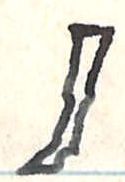 = wḥm = repeat.
= wḥm = repeat.
4 Re, Horus or Harakhte - probably Horus, as the figure has no solar-disk.
"Numerous were the names of the sun-god. The most general one, Re, denotes the
sun itself. Horus or Har-akhte originally stood for the god, regarded as a bird of
prey with blazing eyes, while Khepre denoted the god in form of a beetle.
Finally the evening sun was represented by Atum in the form of an old man.
The sun god is usually represented with the head of a sparrow-hawk summounted
by the sun; this is encircled with its terrible servant, the fire spitting serpent,
who destroys his enemies, for there is no lack of enemies to oppose the progress
of the sun, and one of these, Apophis, the cloud and storm serpent, is the
embodiment of all that is terrible. But they cannot obstruct the progress of the
god, he accomplishes in triumph his journey across the heavens, and in
the evening arrives at the mountain of the west, where he is received by the Goddess
of the West. Here he quits his morning bark in which he travels by day, and
enters the evening bark to begin his mighty journey through the under-world."
3 = green.
= green.
2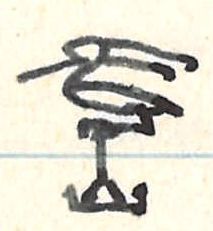 bʿḥ = inundate.
bʿḥ = inundate.  overflowing (see Chap. LXI. B of dead Renouf p. 114)
overflowing (see Chap. LXI. B of dead Renouf p. 114)
over
There he shines forth for the great god Osiris, the eternal Lord. The dead,
however, the inhabitants of the Caverns, greet him joyfully; they lift
up their arms and praise him, they declare unto him their wishes. …
their eyes open once more at the sight of him, and their heart is filled with
joy when they see him. He hears the prayers of those who lie in the
coffins, he
restores breath to their nostrils". (Erman, Egyptian Religion, pp. 10-11).
Tuesday no work. Sent off to Cassells index to Vol. II.
Mons. And Madame Guernier visited the lab.
Undressed, photographed and repaired the two statuettes
275b and d, from Chest 275. The wax treatment proved
successful in both cases and I believe they can now be safely
packed in sawdust. The art of these figures is transitional - El Amarna
and Theban.
Four of these figures were dealt with today.
Conserved, noted the figurines Nos. 280a, 281a, 282a, 283, a, b, c, and
the Meht-writ Cow's head No. 264, and then boxes prepared for packing them.
269.
Examined the contents of box No. 269.
Received a visit from Tewfik Effendi Boulos.
Box No. 269 was found to contain ear-rings, a mirror case, a bead-work
girdle, 2 heq-sceptres and 2 flails. Then several bracelets, a cow-roid
necklace, two pectorals, a bead work apron, a small round bundle of linen
and some scarves.
Received a visit from the Mudir of Keneh together with the Marmour.
Completed investigation of box 269.
Completed examining the material brought up from the tomb; photographed,
cleaned & packed a large proportion of it, so as to make room for more
to be brought up next week.
270. Box No. 270, was found to contain a pair of ornamental slippers, a lid
of a box from 269.a, and an anklet of stone (? Of schist).
Recommenced removing objects from the store room of the tomb,
namely those stored and forming a group in the south east corner.
Here there were sixteen black shrine-like chests (Nos. 290-314305), placed
in four rows parallel with the east wall, and stacked upon them were
nine boats (Nos. 306-314) of four distinct types. Practically all
the chests like the prows of the boats faced towards the West, the exception
being three of the chests, which faced towards the North, they being too
deep to take their proper orientation. One of the boats, the southernmost
(No. 314) had fallen down behind chests Nos. 292 and 296.
We succeeded in removing and the[n] transporting to the laboratory the
nine boats, and to open and examine four of the black chests:-
Completed the examination of the S.E. group of chests, which are now
ready for transport to the laboratory.
Continued examining and cleaning the above discoveries
Went over to Luxor to the inauguration of the broad gauge Luxor-Aswan
rail.
Visit from the Min. of Public Instruction, Ali Pasha Chamsy and
party.
Met the P.M. Ardly Yeghen Pasha
Lucas away at El Amarna Dec 6-16 1926
Ardly Pasha visited the tomb with party.
Newberrys to tea.
These last few days have been employed in tidying up the tomb
preparatory to the visit of the XIVth Congrès International de Navigation
who are to come tomorrow the 19th.
Work stopped in Store-Chamber.
Preserving & recording of material & objects discovered carried on in Lab.
Received visit of King Fuad to tomb & Lab.
H.M. seems very pleased with the results.
Tomb opened
March 15th (afterwards extended to March 31st) (every Tuesday, Thursday & Saturday, 9am to 12 noon).
Sultan el Melek visited the tomb and laboratory.
Left for Aswan. With Tremayne.
Returned Luxor.
Left for Cairo
Arrived Cairo
Left for Luxor
Arrived Luxor
Owing to demands from visitors was obliged to return to Aswan.
Returned to Luxor
Returned to Gurna and recommenced work in Laboratory.
Burton came & continued his
Burton completed his photos.
Tomb closed to tourists.
The Pres. Massaryk came & visited tomb.
Burton made photos of the remaining objects in the Store Chamber.
Landauer left for Cairo
Antiquities to go left by train for Cairo.
Left Gurna - Luxor for Cairo - Arr. Cairo 24th. Stayed at Residency
Dep. Cairo for England.
Arr. London. 11.30pm.


